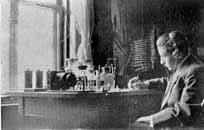(Adapted from "The Twenty-fifth Anniversary Year Book", The Radio Club of America, Inc., 1934)
A HISTORY OF THE
RADIO CLUB OF AMERICA, Inc.
by: George E. Burghard
_________
The story of the Radio Club of America begins over a quarter of a century ago, during the really dark ages of the radio art, about 1907
Here we find a group of small boys, who according to the true American spirit, were so interested in flying that they formed the Junior Aero Club of U. S. under the leadership of Miss Lillian E. Todd. The names of the boys, who were in their early teens, were: Frank King, W. E. D. Stokes, Jr., George Eltz and Frederick Seymour. The members of the club made model planes and attempted to fly them at the regular meetings which were held in a convenient armory. Of course the science of flying was in its infancy at that time, and although their tests were not particularly successful, they were none the less commendable.
In conjunction with their experiments in aviation, these youngsters had, for some time, also been interested in what was then known as WIRELESS. In fact, the new idea of sending messages without wires had proved itself so fascinating, that they found themselves actually devoting most of their spare time to tinkering with wireless apparatus. There were at this time a small number of so-called amateur wireless experimenters in and about New York City, so the boys decided to form a new club with wireless as an object.
Accordingly, Mr. W. E. D. Stokes, Sr., called a special meeting of the Aero Club, for the purpose of forming a new club, with wireless telegraphy and telephony as its main interest. This meeting was held at the Hotel Ansonia in New York City on January 2nd, 1909. There were present Messrs. W. E. D. Stokes, Sr., W. E. D. Stokes, Jr., George Eltz, Frederick Seymour, Frank King, Faitoute Munn, and Miss Todd, the organizer of the Junior Aero Club.
It was unanimously decided to form a new organization to be devoted entirely to Wireless. Thus, the Junior Wireless Club Limited was founded, and the following officers were elected:
Director General- W. E. D. STOKES, SR.
Honorary President- Miss E. L. TODD
Consulting Engineer- PROF. R. A. FESSENDEN
President- W. E. D. STOKES, JR.
Counsel- MR. SEYMOUR
Vice-President- GEORGE ELTZ
Recording Secretary- W. FAITOUTE MUNN
Corresponding Secretary- FRANK KING
Treasurer- FREDERICK SEYMOUR
It was also unanimously decided that these members should be known as the Charter Members.
Of course, the early days of Radio were indeed days of pioneering and darkness, Days when traffic had to be handled with a coherer and a straight gap spark transmitter. There were no books or magazines to guide these boys, but they held regular monthly meetings at the Ansonia, where "Weddy" Stokes lived, on Saturday afternoons, and by swapping information gained the necessary knowledge to build their own receivers and transmitters. The fascination of sending messages through space without wires, readily took hold of the younger generation, and small boys began to inveigle their parents into giving them money with which to buy wire and other material to build sets in imitation of those used by the commercial companies. Their efforts were gallant indeed and the results were successful in some cases, where the frequency of the transmitter happened by chance to be somewhere near that of the receiver, or, someone, had gained expert knowledge from the operators at Manhattan Beach or the Waldorf Astoria, where the main commercial land stations were located. With the crude apparatus and the embryo knowledge available, it was really remarkable that these boys could communicate at all, but almost any night one could hear messages being exchanged between stations in New York City, covering distances of at least a mile or two.
The amateur in these days, of necessity, had to build his own set, since there were no manufacturers other than the Commercial companies. Occasional articles on commercial stations, as they then existed, appeared from time to time and each new idea presented, was added to the experimenter's stock of knowledge. The success of each experiment was passed by word of mouth to the other amateurs and eagerly followed. The Coherer, and in a few cases the Marconi Magnetic Detector, were the detectors in use at that time. All tuning was accomplished by means of sliders on coils of wire wound on the handiest form obtainable, very often being nothing more nor less than a broomstick, rolling pin, or convenient carpet pole. Variometers and variable condensers were then unknown to the amateur.

George Burghard at station "EB", 1 East 93rd St., N. Y. C., 1910.
The apparatus was mostly home-made, the "Helix" in particular,
which was suspended from the ceiling by a string to insure
good insulation.
The transmitters consisted of spark coils, mostly home made, and operated with a mechanical interrupter which was subsequently replaced by the electrolytic type. Most of these interrupters were home made, and lucky was the boy who could boast of the possession of a platinum point neatly sealed in a glass tube.






























